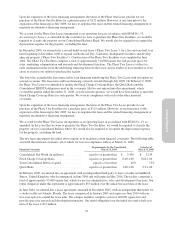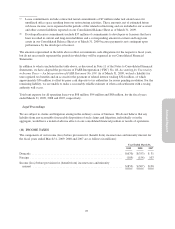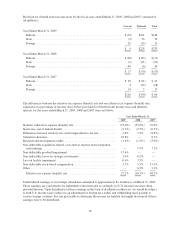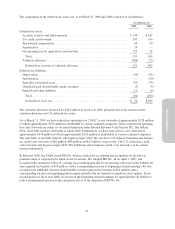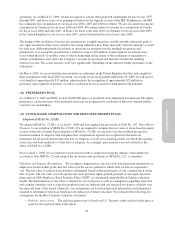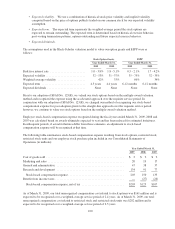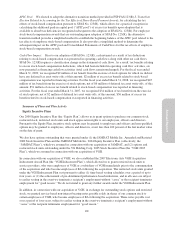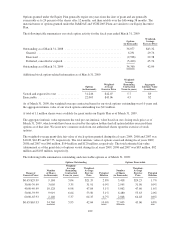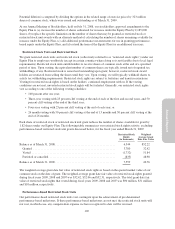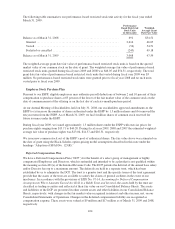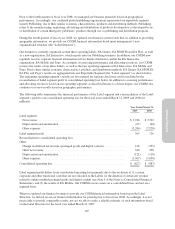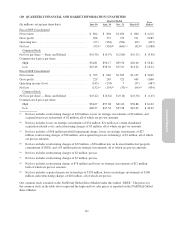Electronic Arts 2009 Annual Report Download - page 181
Download and view the complete annual report
Please find page 181 of the 2009 Electronic Arts annual report below. You can navigate through the pages in the report by either clicking on the pages listed below, or by using the keyword search tool below to find specific information within the annual report.
Annual Report
APIC Pool. We elected to adopt the alternative transition method provided in FSP FAS 123(R)-3, Transition
Election Related to Accounting for the Tax Effects of Share-Based Payment Awards, for calculating the tax
effects of stock-based compensation pursuant to SFAS No. 123(R), which allows for a practical exception in
calculating the additional paid-in capital pool (“APIC pool”) of excess tax benefits upon adoption that is
available to absorb tax deficiencies recognized subsequent to the adoption of SFAS No. 123(R). For employee
stock-based compensation awards that are outstanding upon adoption of SFAS No. 123(R), the alternative
transition method provides a simplified method to establish the beginning balance of the APIC pool related to the
tax effects of employee stock-based compensation. It also provides a simplified method to determine the
subsequent impact on the APIC pool and Consolidated Statements of Cash Flows for the tax effects of employee
stock-based compensation awards.
Cash Flow Impact. Prior to our adoption of SFAS No. 123(R), cash retained as a result of tax deductions
relating to stock-based compensation was presented in operating cash flows along with other tax cash flows.
SFAS No. 123(R) requires a classification change in the statement of cash flows. As a result, tax benefits relating
to excess stock-based compensation deductions, which had been included in operating cash flow activities, are
now presented as financing cash flow activities (total cash flows remain unchanged). For the fiscal year ended
March 31, 2009, we recognized $2 million of tax benefit from the exercise of stock options for which we did not
have any deferred tax asset write-offs; of this amount, $2 million of excess tax benefit related to stock-based
compensation was reported in financing activities. For the fiscal year ended March 31, 2008, we recognized $45
million of tax benefit from the exercise of stock options, net of $6 million of deferred tax asset write-offs; of this
amount, $51 million of excess tax benefit related to stock-based compensation was reported in financing
activities. For the fiscal year ended March 31, 2007, we recognized $34 million of tax benefit from the exercise
of stock options, net of $2 million of deferred tax asset write-offs; of this amount, $36 million of excess tax
benefit related to stock-based compensation was reported in financing activities.
Summary of Plans and Plan Activity
Equity Incentive Plans
Our 2000 Equity Incentive Plan (the “Equity Plan”) allows us to grant options to purchase our common stock,
restricted stock, restricted stock units and stock appreciation rights to our employees, officers and directors.
Pursuant to the Equity Plan, incentive stock options may be granted to employees and officers and non-qualified
options may be granted to employees, officers and directors, at not less than 100 percent of the fair market value
on the date of grant.
We also have options outstanding that were granted under (1) the JAMDAT Mobile Inc. Amended and Restated
2000 Stock Incentive Plan and the JAMDAT Mobile Inc. 2004 Equity Incentive Plan (collectively, the
“JAMDAT Plans”), which we assumed in connection with our acquisition of JAMDAT, and (2) options and
restricted stock units outstanding under the VG Holding Corp. 2005 Stock Incentive Plan (the “VGH 2005
Plan”), which we assumed in connection with our acquisition of VGH.
In connection with our acquisition of VGH, we also established the 2007 Electronic Arts VGH Acquisition
Inducement Award Plan (the “VGH Inducement Plan”), which allowed us to grant restricted stock units to
service providers, who were employees of VGH or a subsidiary of VGH immediately prior to the consummation
of the acquisition and who became employees of EA following the acquisition. The restricted stock units granted
under the VGH Inducement Plan vest pursuant to either (1) time-based vesting schedules over a period of up to
four years, or (2) the achievement of pre-determined performance-based milestones, and in all cases are subject
to earlier vesting in the event we terminate a recipient’s employment without “cause” or the recipient terminates
employment for “good reason.” We do not intend to grant any further awards under the VGH Inducement Plan.
In addition, in connection with our acquisition of VGH, in exchange for outstanding stock options and restricted
stock, we granted service-based non-interest bearing notes payable solely in shares of our common stock to
certain employees of VGH, who became employees of EA following the acquisition. These notes payable vest
over a period of four years, subject to earlier vesting in the event we terminate a recipient’s employment without
“cause” or the recipient terminates employment for “good reason.”
101




